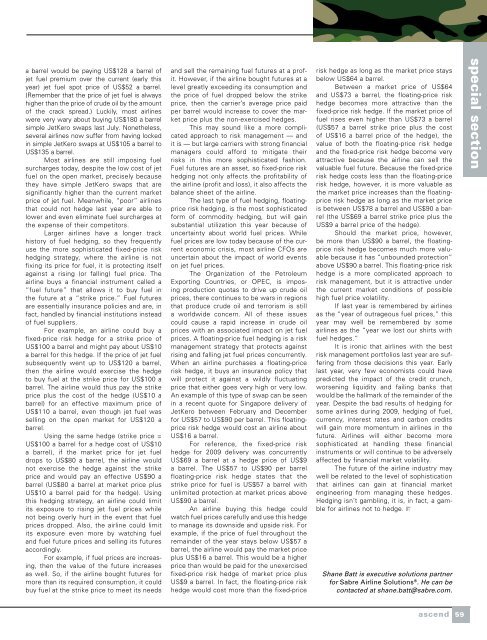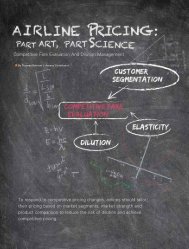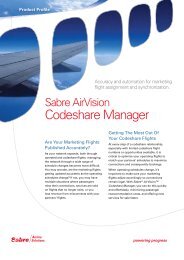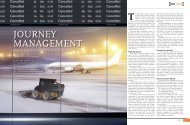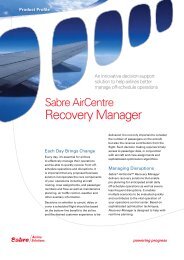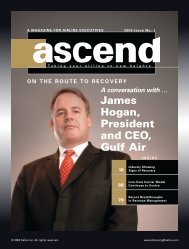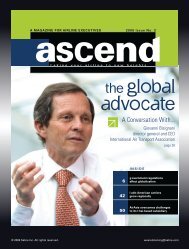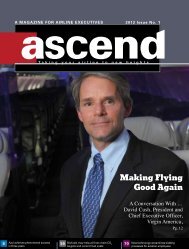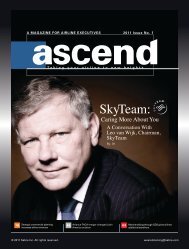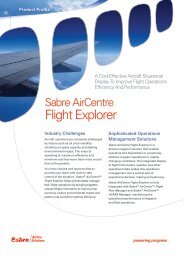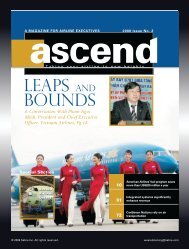2009 Issue 1 - Sabre Airline Solutions
2009 Issue 1 - Sabre Airline Solutions
2009 Issue 1 - Sabre Airline Solutions
You also want an ePaper? Increase the reach of your titles
YUMPU automatically turns print PDFs into web optimized ePapers that Google loves.
a barrel would be paying US$128 a barrel of<br />
jet fuel premium over the current (early this<br />
year) jet fuel spot price of US$52 a barrel.<br />
(Remember that the price of jet fuel is always<br />
higher than the price of crude oil by the amount<br />
of the crack spread.) Luckily, most airlines<br />
were very wary about buying US$180 a barrel<br />
simple JetKero swaps last July. Nonetheless,<br />
several airlines now suffer from having locked<br />
in simple JetKero swaps at US$105 a barrel to<br />
US$135 a barrel.<br />
Most airlines are still imposing fuel<br />
surcharges today, despite the low cost of jet<br />
fuel on the open market, precisely because<br />
they have simple JetKero swaps that are<br />
significantly higher than the current market<br />
price of jet fuel. Meanwhile, “poor” airlines<br />
that could not hedge last year are able to<br />
lower and even eliminate fuel surcharges at<br />
the expense of their competitors.<br />
Larger airlines have a longer track<br />
history of fuel hedging, so they frequently<br />
use the more sophisticated fixed-price risk<br />
hedging strategy, where the airline is not<br />
fixing its price for fuel, it is protecting itself<br />
against a rising (or falling) fuel price. The<br />
airline buys a financial instrument called a<br />
“fuel future” that allows it to buy fuel in<br />
the future at a “strike price.” Fuel futures<br />
are essentially insurance policies and are, in<br />
fact, handled by financial institutions instead<br />
of fuel suppliers.<br />
For example, an airline could buy a<br />
fixed-price risk hedge for a strike price of<br />
US$100 a barrel and might pay about US$10<br />
a barrel for this hedge. If the price of jet fuel<br />
subsequently went up to US$120 a barrel,<br />
then the airline would exercise the hedge<br />
to buy fuel at the strike price for US$100 a<br />
barrel. The airline would thus pay the strike<br />
price plus the cost of the hedge (US$10 a<br />
barrel) for an effective maximum price of<br />
US$110 a barrel, even though jet fuel was<br />
selling on the open market for US$120 a<br />
barrel.<br />
Using the same hedge (strike price =<br />
US$100 a barrel for a hedge cost of US$10<br />
a barrel), if the market price for jet fuel<br />
drops to US$80 a barrel, the airline would<br />
not exercise the hedge against the strike<br />
price and would pay an effective US$90 a<br />
barrel (US$80 a barrel at market price plus<br />
US$10 a barrel paid for the hedge). Using<br />
this hedging strategy, an airline could limit<br />
its exposure to rising jet fuel prices while<br />
not being overly hurt in the event that fuel<br />
prices dropped. Also, the airline could limit<br />
its exposure even more by watching fuel<br />
and fuel future prices and selling its futures<br />
accordingly.<br />
For example, if fuel prices are increasing,<br />
then the value of the future increases<br />
as well. So, if the airline bought futures for<br />
more than its required consumption, it could<br />
buy fuel at the strike price to meet its needs<br />
and sell the remaining fuel futures at a profit.<br />
However, if the airline bought futures at a<br />
level greatly exceeding its consumption and<br />
the price of fuel dropped below the strike<br />
price, then the carrier’s average price paid<br />
per barrel would increase to cover the market<br />
price plus the non-exercised hedges.<br />
This may sound like a more complicated<br />
approach to risk management — and<br />
it is — but large carriers with strong financial<br />
managers could afford to mitigate their<br />
risks in this more sophisticated fashion.<br />
Fuel futures are an asset, so fixed-price risk<br />
hedging not only affects the profitability of<br />
the airline (profit and loss), it also affects the<br />
balance sheet of the airline.<br />
The last type of fuel hedging, floatingprice<br />
risk hedging, is the most sophisticated<br />
form of commodity hedging, but will gain<br />
substantial utilization this year because of<br />
uncertainty about world fuel prices. While<br />
fuel prices are low today because of the current<br />
economic crisis, most airline CFOs are<br />
uncertain about the impact of world events<br />
on jet fuel prices.<br />
The Organization of the Petroleum<br />
Exporting Countries, or OPEC, is imposing<br />
production quotas to drive up crude oil<br />
prices, there continues to be wars in regions<br />
that produce crude oil and terrorism is still<br />
a worldwide concern. All of these issues<br />
could cause a rapid increase in crude oil<br />
prices with an associated impact on jet fuel<br />
prices. A floating-price fuel hedging is a risk<br />
management strategy that protects against<br />
rising and falling jet fuel prices concurrently.<br />
When an airline purchases a floating-price<br />
risk hedge, it buys an insurance policy that<br />
will protect it against a wildly fluctuating<br />
price that either goes very high or very low.<br />
An example of this type of swap can be seen<br />
in a recent quote for Singapore delivery of<br />
JetKero between February and December<br />
for US$57 to US$90 per barrel. This floatingprice<br />
risk hedge would cost an airline about<br />
US$16 a barrel.<br />
For reference, the fixed-price risk<br />
hedge for <strong>2009</strong> delivery was concurrently<br />
US$69 a barrel at a hedge price of US$9<br />
a barrel. The US$57 to US$90 per barrel<br />
floating-price risk hedge states that the<br />
strike price for fuel is US$57 a barrel with<br />
unlimited protection at market prices above<br />
US$90 a barrel.<br />
An airline buying this hedge could<br />
watch fuel prices carefully and use this hedge<br />
to manage its downside and upside risk. For<br />
example, if the price of fuel throughout the<br />
remainder of the year stays below US$57 a<br />
barrel, the airline would pay the market price<br />
plus US$16 a barrel. This would be a higher<br />
price than would be paid for the unexercised<br />
fixed-price risk hedge of market price plus<br />
US$9 a barrel. In fact, the floating-price risk<br />
hedge would cost more than the fixed-price<br />
risk hedge as long as the market price stays<br />
below US$64 a barrel.<br />
Between a market price of US$64<br />
and US$73 a barrel, the floating-price risk<br />
hedge becomes more attractive than the<br />
fixed-price risk hedge. If the market price of<br />
fuel rises even higher than US$73 a barrel<br />
(US$57 a barrel strike price plus the cost<br />
of US$16 a barrel price of the hedge), the<br />
value of both the floating-price risk hedge<br />
and the fixed-price risk hedge become very<br />
attractive because the airline can sell the<br />
valuable fuel future. Because the fixed-price<br />
risk hedge costs less than the floating-price<br />
risk hedge, however, it is more valuable as<br />
the market price increases than the floatingprice<br />
risk hedge as long as the market price<br />
is between US$78 a barrel and US$90 a barrel<br />
(the US$69 a barrel strike price plus the<br />
US$9 a barrel price of the hedge).<br />
Should the market price, however,<br />
be more than US$90 a barrel, the floatingprice<br />
risk hedge becomes much more valuable<br />
because it has “unbounded protection”<br />
above US$90 a barrel. This floating-price risk<br />
hedge is a more complicated approach to<br />
risk management, but it is attractive under<br />
the current market conditions of possible<br />
high fuel price volatility.<br />
If last year is remembered by airlines<br />
as the “year of outrageous fuel prices,” this<br />
year may well be remembered by some<br />
airlines as the “year we lost our shirts with<br />
fuel hedges.”<br />
It is ironic that airlines with the best<br />
risk management portfolios last year are suffering<br />
from those decisions this year. Early<br />
last year, very few economists could have<br />
predicted the impact of the credit crunch,<br />
worsening liquidity and failing banks that<br />
would be the hallmark of the remainder of the<br />
year. Despite the bad results of hedging for<br />
some airlines during <strong>2009</strong>, hedging of fuel,<br />
currency, interest rates and carbon credits<br />
will gain more momentum in airlines in the<br />
future. <strong>Airline</strong>s will either become more<br />
sophisticated at handling these financial<br />
instruments or will continue to be adversely<br />
affected by financial market volatility.<br />
The future of the airline industry may<br />
well be related to the level of sophistication<br />
that airlines can gain at financial market<br />
engineering from managing these hedges.<br />
Hedging isn’t gambling, it is, in fact, a gamble<br />
for airlines not to hedge. a<br />
Shane Batt is executive solutions partner<br />
for <strong>Sabre</strong> <strong>Airline</strong> <strong>Solutions</strong> ® . He can be<br />
contacted at shane.batt@sabre.com.<br />
ascend<br />
59<br />
special section


